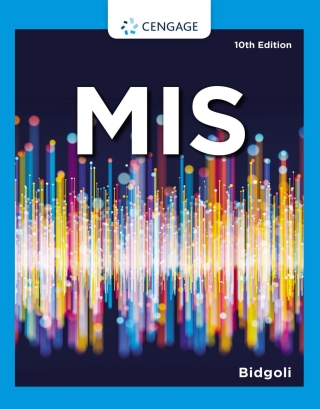Buy MIS, 10th Edition PDF ebook by author Hossein Bidgoli – published by Cengage Learning in 2021 and save up to 80% compared to the print version of this textbook. With PDF version of this textbook, not only save you money, you can also highlight, add text, underline add post-it notes, bookmarks to pages, instantly search for the major terms or chapter titles, etc.
You can search our site for other versions of the MIS, 10th Edition PDF ebook. You can also search for others PDF ebooks from publisher Cengage Learning, as well as from your favorite authors. We have thousands of online textbooks and course materials (mostly in PDF) that you can download immediately after purchase.
Note: e-textBooks do not come with access codes, CDs/DVDs, workbooks, and other supplemental items.
eBook Details:
Full title: MIS, 10th Edition
Edition: 10th
Copyright year: 2021
Publisher: Cengage Learning
Author: Hossein Bidgoli
ISBN: 9780357418697, 9780357419304
Format: PDF
Description of MIS, 10th Edition:
Master the foundational principles of MIS as you explore today’s latest developments and industry trends with MIS 10. This practically focused approach helps you explore MIS concepts and advancements that will enhance your career and professional success. You examine the latest topics, such as cloud computing, AR/VR, quantum computing and blockchain, with the most current MIS title on the market. New case studies and information boxes connect the principles you are learning to the most current events in technology and business today. MIS 10 explains the technology behind recent business cases, such as cryptocurrency, 5G and its business applications and use of VR in the workplace. Succinct, yet thorough, modules keep your interest and prepare you to face today’s MIS challenges with success.Important Notice: Media content referenced within the product description or the product text may not be available in the ebook version.
Table of Contents of MIS, 10th Edition PDF ebook:
Brief ContentsContentsPart 1: Fundamentals of Information SystemsChapter 1: Information Systems in Business1-1 Computers and Information Systems in Daily Life1-2 Computer Literacy and Information Literacy1-3 The Beginning: Transaction-Processing Systems1-4 Management Information Systems1-5 Major Components of an Information System1-6 Using Information Systems and Information Technologies1-7 The IT Job Market1-8 Outlook for the FutureModule SummaryKey TermsReviews and DiscussionsProjectsModule QuizCase Study 1-1: Using Information Technologies at Federal ExpressCase Study 1-2: Mobile Technology: A Key Player for Future ShoppingChapter 2: Computers and Their Business Applications2-1 Defining a Computer2-2 The History of Computer Hardware and Software2-3 The Power of Computers2-4 Computer Operations2-5 Input, Output, and Memory Devices2-6 Classes of Computers2-7 What Is Software?2-8 Computer Languages2-9 Object-Oriented Programming: A Quick OverviewModule SummaryKey TermsReviews and DiscussionsProjectsModule QuizCase Study 2-1: Become Your Own Banker and Financial AdvisorCase Study 2-2: iPads: New Productivity Tools for Service WorkersChapter 3: Data and Business Intelligence3-1 Databases3-2 Logical Database Design3-3 Components of a DBMS3-4 Recent Trends in Database Design and Use3-5 Data Warehouses3-6 Data Marts3-7 Business Analytics3-8 The Big Data Era3-9 Database Marketing3-10 Tableau and Power BI: Two Popular BI and Visualization PlatformsModule SummaryKey TermsReviews and DiscussionsProjectsModule QuizCase Study 3-1: Data Mining Helps Students Enroll in Courses with Higher Chances of SuccessCase Study 3-2: Data Mining Tools at Pandora RadioChapter 4: Personal, Legal, Ethical, and Organizational Issues4-1 Privacy Issues4-2 Ethical Issues of Information Technologies4-3 The Impact of Information Technology in the Workplace4-4 Green ComputingModule SummaryKey TermsReviews and DiscussionsProjectsModule QuizCase Study 4-1: Telecommuting with a New TwistCase Study 4-2: Privacy and Other Legal Issues at GoogleChapter 5: Protecting Information Resources5-1 Risks Associated with Information Technologies5-2 Computer and Network Security: Basic Safeguards5-3 Security Threats: An Overview5-4 Security Measures and Enforcement: An Overview5-5 Guidelines for a Comprehensive Security SystemModule SummaryKey TermsReviews and DiscussionsProjectsModule QuizCase Study 5-1: Vulnerabilities of Medical DevicesCase Study 5-2: Security Breach at EquifaxPart 2: Data Communication, the Internet, E-Commerce, and Global Information SystemsChapter 6: Data Communication: Delivering Information Anywhere and Anytime6-1 Defining Data Communication6-2 Basic Components of a Data Communication System6-3 Processing Configurations6-4 Types of Networks6-5 Network Topologies6-6 Major Networking Concepts6-7 Wireless and Mobile Networks6-8 Wireless Security6-9 Convergence of Voice, Video, and DataModule SummaryKey TermsReviews and DiscussionsProjectsModule QuizCase Study 6-1: Data Communication at WalmartCase Study 6-2: Protecting the Security and Privacy of Mobile DevicesChapter 7: A Connected World7-1 The Internet7-2 Navigational Tools, Search Engines, and Directories7-3 Internet Services7-4 Web Applications7-5 Intranets7-6 Extranets7-7 The Web Trends7-8 The Internet of Everything and BeyondModule SummaryKey TermsReviews and DiscussionsProjectsModule QuizCase Study 7-1: Scotts Miracle-Gro’s Intranet: The GardenCase Study 7-2: Social Networking in Support of Small BusinessesChapter 8: E-Commerce8-1 Defining E-Commerce8-2 Major Categories of E-Commerce8-3 B2C E-Commerce Cycle8-4 B2B E-Commerce: A Second Look8-5 Mobile and Voice-Based E-Commerce8-6 E-Commerce Supporting Technologies8-7 E-Commerce and Beyond: Social Commerce8-8 Hypersocial Organizations8-9 Social Media Information SystemsModule SummaryKey TermsReviews and DiscussionsProjectsModule QuizCase Study 8-1: Widespread Applications of Mobile AdsCase Study 8-2: Bridging the Gap between E-Commerce and Traditional CommerceChapter 9: Global Information Systems9-1 Why Go Global?9-2 Global Information Systems: An Overview9-3 Organizational Structures and Global Information Systems9-4 Obstacles to Using Global Information SystemsModule SummaryKey TermsReviews and DiscussionsProjectsModule QuizCase Study 9-1: Global Information Systems at Toyota Motor CompanyCase Study 9-2: Information Technologies Support Global Supply ChainPart 3: IS Development, Enterprise Systems, MSS, and Emerging TrendsChapter 10: Building Successful Information Systems10-1 Systems Development Life Cycle: An Overview10-2 Phase 1: Planning10-3 Phase 2: Requirements Gathering and Analysis10-4 Phase 3: Design10-5 Phase 4: Implementation10-6 Phase 5: Maintenance10-7 New Trends in Systems Analysis and DesignModule SummaryKey TermsReviews and DiscussionsProjectsModule QuizCase Study 10-1: Systems Development at SEB LatviaCase Study 10-2: Crowdsourcing Pays OffChapter 11: Enterprise Systems11-1 Supply Chain Management11-2 Customer Relationship Management11-3 Knowledge Management11-4 Enterprise Resource Planning11-5 Cloud-Based Enterprise SystemsModule SummaryKey TermsReviews and DiscussionsProjectsModule QuizCase Study 11-1: ERP at Johns Hopkins InstitutionsCase Study 11-2: CRM at StarbucksChapter 12: Supporting Decisions and Processes12-1 Types of Decisions in an Organization12-2 Decision Support Systems12-3 Executive Information Systems12-4 Geographic Information Systems12-5 Collaboration Systems12-6 Guidelines for Designing a Management Support SystemModule SummaryKey TermsReviews and DiscussionsProjectsModule QuizCase Study 12-1: UPS Deploys Routing Optimization with a Big PayoffCase Study 12-2: GPS Technology and Analytics Combat CrimeChapter 13: Artificial Intelligence and Automation13-1 What Is Artificial Intelligence?13-2 Expert Systems13-3 Case-Based Reasoning13-4 Intelligent Agents13-5 Fuzzy Logic13-6 Machine Learning13-7 Genetic Algorithms13-8 Natural-Language Processing13-9 Integrating AI Technologies into Decision Support Systems13-10 Contextual Computing: Making Mobile Devices Smarter13-11 AI and Automation13-12 Ethical issues of AIModule SummaryKey TermsReviews and DiscussionsProjectsModule QuizCase Study 13-1: AI-Based Software Helps Businesses Better Understand CustomersCase Study 13-2: NLP: Making a Smartphone SmarterChapter 14: Emerging Trends, Technologies, and Applications14-1 Trends in Software and Service Distribution14-2 Virtual Reality14-3 Cloud Computing: Foundation, Applications, and Models14-4 Nanotechnology14-5 Blockchain Technology and Cryptocurrency14-6 Quantum ComputingModule SummaryKey TermsReviews and DiscussionsProjectsModule QuizCase Study 14-1: Cloud Computing at Intercontinental Hotels Group (IHG)Case Study 14-2: Virtual Reality Enhances Try before You Buy ConceptEndnotesIndex





